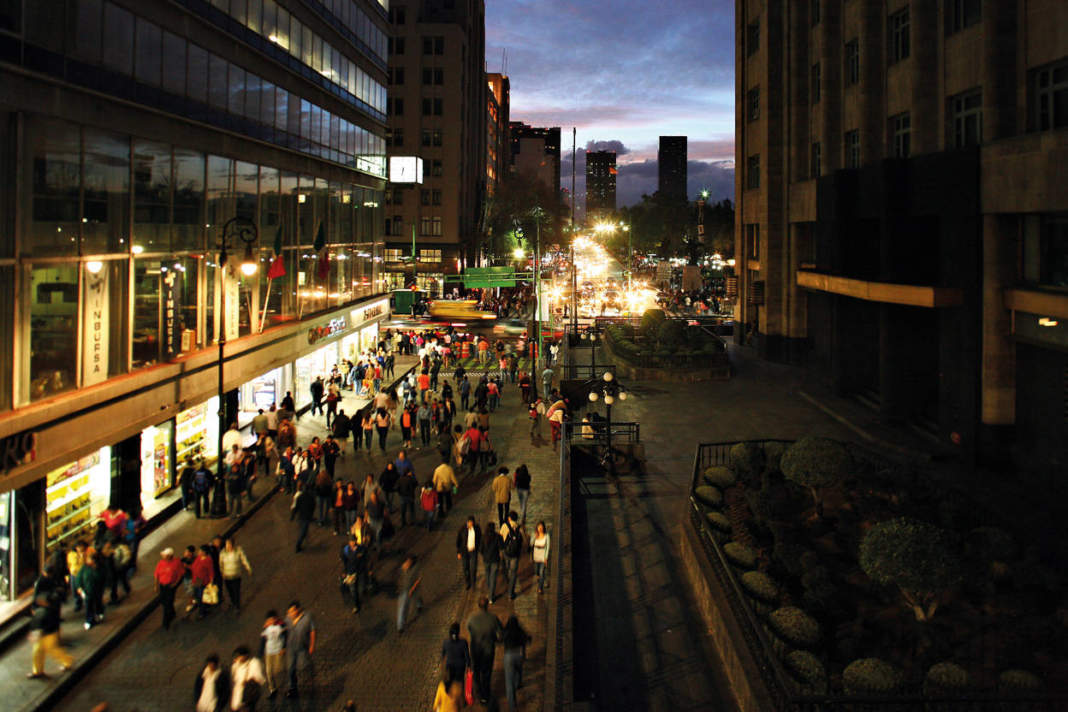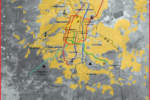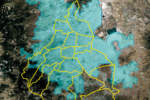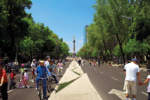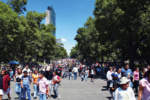Marella Santangelo: What town planning instruments are currently used in Mexico City, and what plans and programs do you adopt?
Felipe Leal: A number of planning instruments are used, as for instance the General Urban Development Plan (PDU) for the city, which is based on the Delegation Plans. Mexico city is divided in sixteen areas or delegations, which have their own urban development plans (PDDUs) which indicate how the land is to be used, the vocations of the territory and its potentials, for instance whether there are industrial, commercial, residential or tertiary areas or other elements. While the definitions are not as clear and rigid as in modern zoning, these plans nevertheless identify the kind of streets and roads and the urban structure of the city, as well as the different types of use of the land that are compatible with its development. The General Urban Development Plan comprises all the areas that make up the city. Just as Paris has a sixteenth, fourteenth or fifteenth arrondissement, Mexico is organized in delegations, each with an own Delegation Plan, which is always coordinated with the General Plan; in fact, the delegation plans are not autonomous, but part of the General Plan. The Plan is indicative and provides the general criteria, while the Delegation plan is much more specific, with detailed information on every street and area in that delegation. A further level of in-depth planning is provided by the Partial Plans, detailed plans of the single areas which call for special management.
Every part of the city has an Urban Development Plan; furthermore, some areas as the old town or Xochimilco, the former of which is a cultural heritage and the latter a nature reserve, are governed by Partial Plans.
M.S.: Is it possible to envisage or identify, through these instruments, more appropriate ones in order to invert the negative processes affecting Mexico City, and thus launch a new phase in the government of urban modifications?
F.L.: While restrictive, these instruments are, in my opinion, clearly insufficient. Instruments as the PDU or the PDDU help to approximately indicate the direction in which Mexico City is developing. However, due to the dynamics and the exponential growth of the city they are certainly quite short-lived.
Four or five years after their creation, these plans have already been superseded by the actual situation, the market conditions, real estate speculation and the way we, its inhabitants, use the city. I therefore believe that while they are certainly valid instruments, they are not sufficient to plan the future. And it is necessary to be able to count on a strategy and a project for the future which makes it possible to change a whole series of social attitudes; it is therefore indispensable that these instruments be changed.
M.S.: In your opinion, are the decisions of the municipal administration motivated by a general and comprehensive strategy?
F.L.: A general strategy already exists on a decision-making level. A series of phenomena have occurred in Mexico City which have made the administration change approach, seeking other strategies of thought and, consequently, other decision-making strategies. The population growth and the ever greater need for dwellings in the central area of the city has resulted in an increase and improvement of the public spaces, and a demand for a system of alternative and different transport networks. These premises have given rise not only to a new concept but also to a new strategy, and the definition of three very clear goals for the city: better public spaces, better public transport or alternative vehicle (as bicycles or electric cars), repopulation of the downtown areas through new dwellings. The dwelling is a crucial element of the development strategies, because people live in precarious conditions, in buildings of very bad quality, in a large part of the city. We are not only working to improve the quality of the dwellings themselves, but also the cohesion of the neighbourhoods, building and renovating urban areas, and this may give the city itself an identity in the near future. Our general strategy centres on actions aimed at creating a more compact city, meeting the need for housing in the centre and not on the city outskirts, unlike the planners of the last decades. We want a city where it is possible to spend less time travelling from one point to another, by improving mobility and public spaces.
M.S.: Can the historical architectural heritage be considered a strategic element, on which basis to launch a process aimed at the renovation and enhancement of the entire centre of Mexico City?
F.L.: The old town plays an important role in terms of urban identity, and is a good example of the physical transformation of the city. The architecture heritage of the downtown areas has acted as detonator and strategic element, in which the city recognizes itself, and with which its inhabitants identify. The renovation has triggered a series of initiatives which have not only concerned the colonial past, and which have motivated other renovation projects, also in areas which were previously neglected because they were less attractive or belonged to a less remote past, as the industrial areas. Certainly, the architectural heritage is not the only element you identify with the city. I believe that also the natural heritage, as the parks, the alleys, the gardens, the forests and the ravines characterize the identity of the place. Initiatives aimed at recovering our geographic, climatic and natural identity have therefore been launched, through projects aimed at revitalizing the rivers, ravines and also the public areas.
M.S.: The General Urban Development Program of the Federal District establish the priorities for the future development of the city and the preferential axes, but the question of recognizing a centrality is perhaps the most crucial element for purposes of reinforcing the urban structure.
F.L.: The General Urban Development Plan defines what we know as urban corridors. The fulcrum is the centre of the city, with a series of urban corridors from which other forms of service agglomerations branch out, not only concentrically but also through linear corridors. Axes like the Paseo de la Reforma and Insurgentes host activities that are much more vivacious than the self-same city centre or Polanco. Due to the mobility and dimension of the city, the corridors currently play a very important role. They undoubtedly form a grid, a tissue, an urban web, an aggregate of corridors with their respective centres, not a single centre.
M.S.: The system of infrastructures has given the urban territory character, playing a strategic and primary role in the current transformation of the city; a kind of “infrastructural emphasis” has taken place, but these systems have very often remained completely separated from the urban tissue.
F.L.: Many of the viability works, especially the second-level roads, or thoroughfares, highways or ring roads interrupt the urban tissue, which has been broken into fragments. I believe only London has escaped this kind of fate, but most large cities as New York, Paris, Mexico City, Sao Paolo have suffered from these “scars” which we must, with the passing of time, heal and recover because we hope to be able to move in a different way one day. The infrastructure has always been prioritized over the urban tissue. In Mexico City we are inverting this order with the creation of a body responsible for the public space; issues associated with the public space are today very important, in order to create an urban tissue which is not dominated by infrastructures.
M.S.: Is it today possible to speak of an identity of Mexico City, and in what terms? What structural elements help us identify it?
F.L.: The identity of Mexico City lies in its dimension: the fact that it is a megalopolis, its metropolitan and multicultural spirit imbued in its scheme. It is not as multicultural as Amsterdam or Berlin, but it certainly is so in the sense that many cultures coexist within Mexico City. The city has been founded as a metropolis and I believe this is the key to its identity: it is a different city, full of surprises with many unusual spaces which surprise even us, its inhabitant; it reveals riches and variety. This variety is reflected by the districts, which are very different from one another: Azcapotzalco, Coyoacán, San Ángel, the Centro Histórico, Mixcoac… each of them has its own peculiarities. Mexico City is many cities in one, perhaps this is its most peculiar trait.
M.S.: Does the architecture of Mexico City vaunt a specific character, and can architecture still contribute to a new quality of the urban space?
F.L.: There is no specific architectural approach, but there is undoubtedly a characteristic Mexican architecture, which reflects the favourable climate. Keeping this environmental premise in mind, it is possible to distinguish three main genres in the architecture of Mexico City, the most important being the architecture of a symbolic and monumental character, which has profound historical roots dating back to the Mesoamerican period; this architecture dominates the scene, with strong lines, large dimensions and generous plans.
The second genre is that of commercial architecture, which has dominated part of the international scenario, an architecture which can be found anywhere in the world, which conforms with the codes of international economic consumption. The third genre centres on a vernacular and domestic scale, it reflects the way we Mexicans live, the importance of the home and the family structure, and it tells the story of how much time we dedicate to it. All this is revealed by the plan rather than by the form.
In terms of design the public building is very magniloquent, evocative, generous, Pharaonic. The commercial architecture is more international, it could be anywhere in the world, while the domestic architecture is characterized by the peculiar use, by the distribution and the character of the space. At this point these three lines interrelate, giving the urban space a new quality, half-way between public and private. I believe that in the next decade we will witness a profound transformation of the quality of life in Mexico City, in the direction of an exploitation of the public space and the way it relates to the built private space. All this is already happening in Paseo de la Reforma, and the result is a different and new urban density, which vaunts a close relationship with the systems of mobility and with repercussions in terms of an intense use of the public space and, consequently, in a qualitative and substantial improvement of the latter.
M.S.: How do you, from your privileged observatory as Secretary of SEDUVI, see the future of Mexico City and what may the role of the dwelling, which still seems to be very important, be?
F.L.: The dwelling plays a fundamental role. We should build about 40,000 apartments a year and we fail to do so because we lack the resources. It is very important to satisfy the requirement for housing, to meet the needs of people living in precarious conditions or in marginal places on the outskirts of Mexico City.
The dwelling makes the city, and where dwellings are built the life of the neighbourhood is improved, an urban web of streets, parks and people is formed, and all this contributes to make the quality of life. We are cooperating with banks and lenders as INFONAVIT (Instituto del Fondo Nacional de la Vivienda) which is the national organization for the promotion of the dwelling.
We also work with private investors to ideate and develop a very aggressive program for the next three years, and thus consolidate many neighbourhoods of the city which used to be industrial districts, with workshops or factories that have closed or are no longer in use or abandoned, in order to develop residential districts with sustainable criteria, including an intensive use of the public space; this has resulted in the creation of new parks, green areas and neighbourhoods where the residents can count on instruments as the collection of rainwater, energy-saving devices and efficient alternative means of transport.
M.S.: In conclusion, could you, as a militant architect who is also involved in institutional activities, briefly describe your idea of city?
F.L.: The ideal city is leaving the urban utopias conceived for the 20th century behind. I consider the ideal city, in the case of Mexico City, to be a more compact city with high quality public spaces, a lot of green areas and alternative means for a different mobility. My ideal city is a vertical, denser city, where the car plays a less and less important role, where the transport is efficient and where the continuity between public spaces and green areas prevails.
Felipe Leal (1956), architect, is a member of the Architecture Department of the UNAM, and has been Department Chairman twice, between 1997 and 2004. Since 2009 he heads the office of the Secretaría de Desarrollo Urbano y Vivienda (Seduvi) of Mexico City. In 1991 he founded an architecture studio and in 2008 received mention at the 10th Biennial of Architecture with the Unidad Académica y Cultural Morelia and the Metrobus Station of the University City. In 2005 he received recognition of university merit for his 25 years of academic work and in 2003 he won the Ricardo de Robina Award for the spread of architecture. He has taught at Harvard, Columbia University and in the main universities of South America, in France, Italy and Spain.


